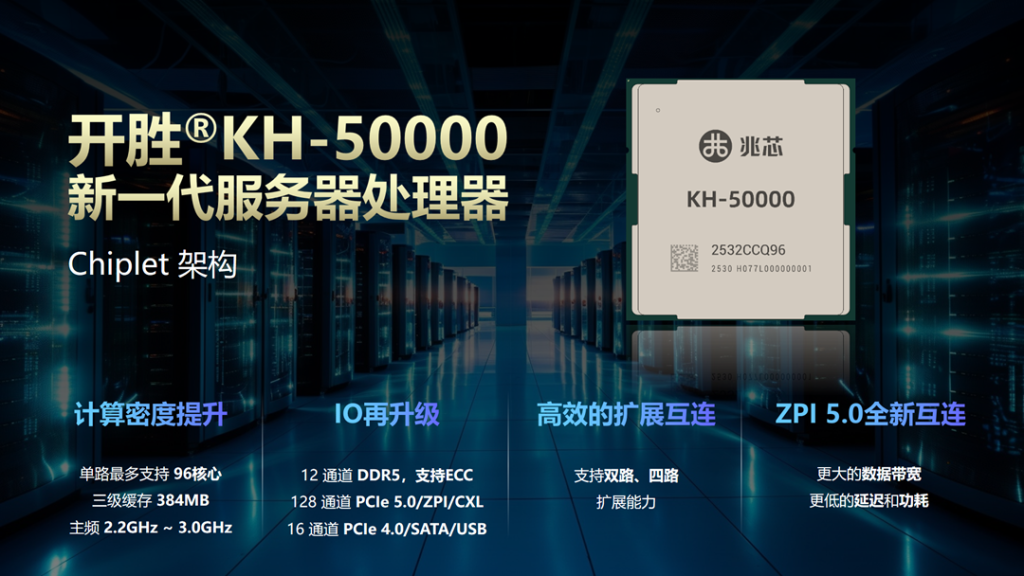In a significant technological advancement for China’s server ecosystem, Zhaoxin has announced its next-generation KH-5000 Chiplet CPUs, boasting an impressive configuration of up to 96 cores. This launch signals Zhaoxin’s commitment to enhancing domestic computing capabilities to support the growing demand for server power in various sectors, including cloud computing, artificial intelligence (AI), and high-performance computing.
Overview of the KH-5000 Chiplet CPUs
Currently, the KH-4000 series stands as Zhaoxin’s flagship server CPU offering, featuring up to 32 cores, 32 threads, and a memory bandwidth support of up to 128 PCIe 4.0 lanes. These CPUs have been in circulation since the fourth quarter of 2022 and have gained traction for their performance. However, the technology landscape is ever-evolving, and Zhaoxin is poised for a substantial leap forward with the KH-5000 series, announced at the Shanghai World Expo 2025. This next-generation chip reinforces the idea that Zhaoxin aims to solidify its position in the global server market by enhancing core counts and I/O capabilities.
Key Specifications and Features
The KH-5000 series is built on a chiplet architecture, enabling modular designs that provide scalability and flexibility based on application requirements. Here are the key specifications of the KH-5000 CPUs:
- Up to 96 cores, significantly increasing from the previous 32 cores in the KH-4000 series.
- Core performance is expected to improve with a projected 30% increase in instructions per cycle (IPC).
- A robust cache configuration, with the top SKU featuring up to 384 MB of cache.
- Base clock speeds of 2.0 GHz, with a boost capability of up to 3.0 GHz.
- Support for 12-channel DDR5 memory, which enhances memory bandwidth and efficiency compared to the 8-channel DDR4 in the prior generation.
- A total of 128 PCIe 5.0 lanes, offering improved data transfer rates and expanded connectivity options.
- The new ZPI 5.0 interconnect technology, allowing for dual and quad-socket configurations.
For context, the introduction of the ZPI 5.0 interconnect is crucial. This technology not only supports expanded throughput but also reduces latency and power consumption—a determining factor for data centers and enterprises striving for efficient operations. The potential for up to 384 cores on a single motherboard with four CPUs can revolutionize the way companies approach server deployments and workloads.
Comparative Analysis: KH-5000 vs. KH-4000
The advancements with the KH-5000 series can be contrasted with its predecessor, the KH-4000 series, as follows:
- **Core Count:** 96 Cores vs. 32 Cores
- **Peak Clock Speed:** 3.0 GHz vs. 2.5 GHz
- **Cache Size:** 384 MB vs. 64 MB
- **Memory Support:** 12-Channel DDR5 vs. 8-Channel DDR4
- **PCIe Lanes:** 128 PCIe 5.0 vs. 128 PCIe 4.0
- **Interconnect Technology:** ZPI 5.0 vs. ZPI 3.0
These enhancements highlight Zhaoxin’s dedication to improving server capabilities, which is vital as industries increasingly adopt more complex and data-intensive applications. Notably, a report from Statista indicates that China’s cloud computing market is expected to reach approximately $114 billion by 2025, underscoring the need for powerful server solutions.
Future Developments and Market Impact
Alongside the KH-5000 CPUs, Zhaoxin also introduced the KX-7000N, which integrates a dedicated Neural Processing Unit (NPU) to enhance AI capabilities. This move indicates a strategic push into the “AI PC” segment, with expectations for even more powerful consumer CPUs featuring higher core counts and advanced architectures designed to support AI workloads. As Zhaoxin continues to innovate, it aims to cater to both enterprise and consumer markets, potentially altering the competitive landscape currently dominated by larger entities like Intel and AMD.
It remains unclear when the KH-5000 series will become widely available, but anticipation is high within the tech community for its potential impact on server performance in China. The release of these chips signifies not just a technological upgrade, but also a step towards greater self-reliance in high-performance computing for Chinese enterprises.
In summary, Zhaoxin’s KH-5000 Chiplet CPUs represent a definitive advancement in China’s server capabilities, responding to growing domestic needs for robust computing power. As the market continues to evolve, Zhaoxin’s innovations may pave the way for new standards in server technology that resonate well beyond China.

